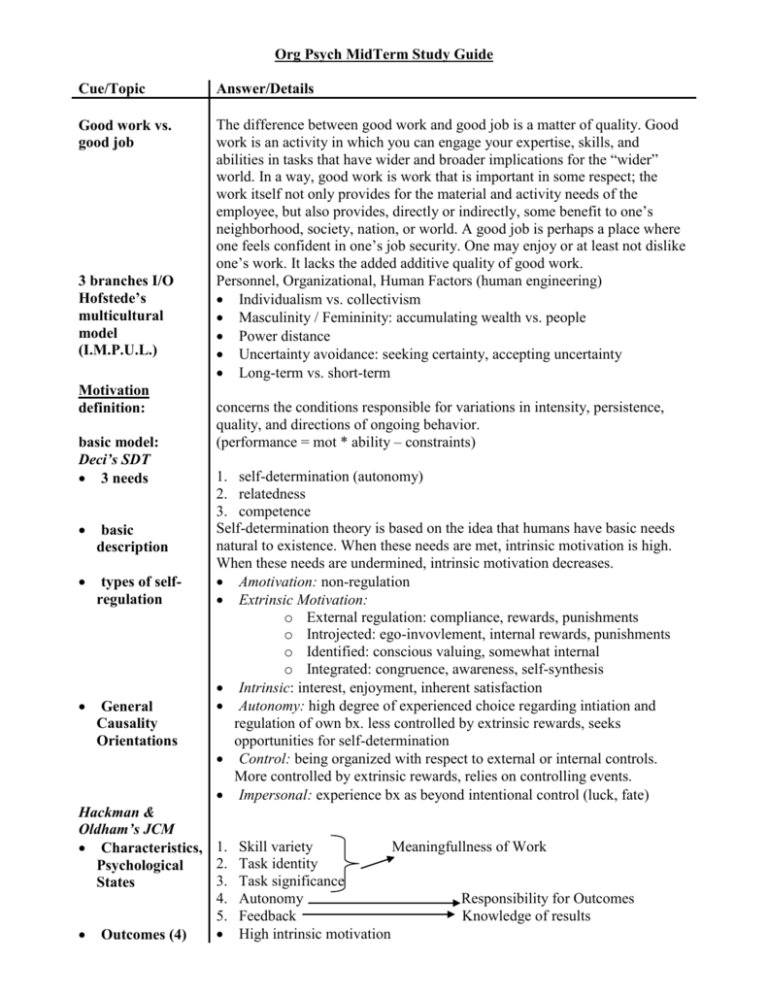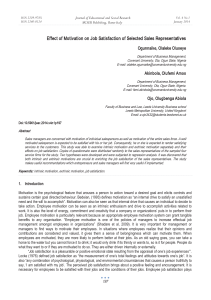Org Psych MidTerm Study Guide
advertisement

Org Psych MidTerm Study Guide Cue/Topic Answer/Details Good work vs. good job The difference between good work and good job is a matter of quality. Good work is an activity in which you can engage your expertise, skills, and abilities in tasks that have wider and broader implications for the “wider” world. In a way, good work is work that is important in some respect; the work itself not only provides for the material and activity needs of the employee, but also provides, directly or indirectly, some benefit to one’s neighborhood, society, nation, or world. A good job is perhaps a place where one feels confident in one’s job security. One may enjoy or at least not dislike one’s work. It lacks the added additive quality of good work. Personnel, Organizational, Human Factors (human engineering) Individualism vs. collectivism Masculinity / Femininity: accumulating wealth vs. people Power distance Uncertainty avoidance: seeking certainty, accepting uncertainty Long-term vs. short-term 3 branches I/O Hofstede’s multicultural model (I.M.P.U.L.) Motivation definition: basic model: Deci’s SDT 3 needs basic description types of selfregulation General Causality Orientations concerns the conditions responsible for variations in intensity, persistence, quality, and directions of ongoing behavior. (performance = mot * ability – constraints) 1. self-determination (autonomy) 2. relatedness 3. competence Self-determination theory is based on the idea that humans have basic needs natural to existence. When these needs are met, intrinsic motivation is high. When these needs are undermined, intrinsic motivation decreases. Amotivation: non-regulation Extrinsic Motivation: o External regulation: compliance, rewards, punishments o Introjected: ego-invovlement, internal rewards, punishments o Identified: conscious valuing, somewhat internal o Integrated: congruence, awareness, self-synthesis Intrinsic: interest, enjoyment, inherent satisfaction Autonomy: high degree of experienced choice regarding intiation and regulation of own bx. less controlled by extrinsic rewards, seeks opportunities for self-determination Control: being organized with respect to external or internal controls. More controlled by extrinsic rewards, relies on controlling events. Impersonal: experience bx as beyond intentional control (luck, fate) Hackman & Oldham’s JCM Meaningfullness of Work Characteristics, 1. Skill variety 2. Task identity Psychological 3. Task significance States 4. Autonomy Responsibility for Outcomes 5. Feedback Knowledge of results High intrinsic motivation Outcomes (4) Moderators (4) Relationship Between JCM and SDT (3) Other Theories (4) Effective Pay strategies (5 + groups & individuals) Defective pay strategies (5) Work Attitudes 3 components of attitude mood vs. emotion core selfevaluations High job performance High job satisfaction low absenteeism and turnover Growth need strength job as vehicle for personal growth, sense of achievement, etc. Knowledge and skills Satisfaction with extrinsic aspect of work Both are concerned with autonomy as an important psychological state which is related to intrinsic motivation. JCM’s feedback can be autonomy supportive (informational) or controlling. controlling feedback tends to decrease motivation, while informational feedback supports intrinsic motivation. Differing levels of growth needs, etc. should be placed in corresponding work situations. Vroom’s VIE: valence, instrumentality, expectancy. motivation is a function of the interaction of these three variables. Festinger’s Dissonance theory: Adam’s Equity Theory: Perceived discripancy between input/output ratio for self and ratio for others leads to psychological states. Goal-setting theory (Locke): goal is motivational force; need to accept (commit) to goals; goals should be optimal (difficult, but obtainable). Incorporates feedback loop! Important construct in motivation. set high goals for performance develop accurate ways to measure performance train supervisors in appraisal link pay to performance make increases noticeable and meaningful For groups: team incentives, stock options, gain/profit sharing For individuals; tied to individual performance bonuses or merit pay is too small non-existent link b/w pay and performance poor perf appraisal effect of unions adaptation problems belief evaluation bx intention moods are more enduring – not tied to specific stimulus or environmental event; also partly dispositional. (think PA and NA) Def: self-assessment of circumstances. includes: o self-esteem: estimation of social standing, value to others o self-efficacy: belief in one’s ability to successfully accomplish task o locus of control: internal vs. external causation of life events o absence of neuroticism Predicts: o perceptions of work characteristics o job satisfaction o life satisfaction Job Satisfaction definition/hx Spector – JSS JDI – Smith, Kendall Types of Satisfaction Work Commitment Def: “positive attitude or emotional state resulting from the appraisal or one’s job or job exeperience.” know Hawthorne effect Is it a dependent or independent variable? Small relationship with job performance, commitment, abstenteeism, etc. Job Satisfaction Survey facet satisfaction: pay, promo, supervision, conditions, coworkers, etc. Job Descriptive Index facet satisfaction Progressive Satisfaction: attempts to achieve higher level of current satisfaction Stabilized: motivated to maintain current level Resigned: decrease aspiration to maintain satisfaction Pseudo: denail of negative work situation Constructive Dissatisfaction: attempts to master situation Fixated: gets stuck in problems Affective:**emotional attachment Continuance: avoid cost of quitting Normative: obligation Different commitment levels to different aspects of job





